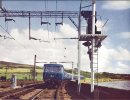It's surprising there was any use made of Helensburgh Upper station, with its handful of services per day, probably not too punctual in the Up direction, compared to the regular electric service from the main station down the hill.
Helensburgh Upper is situated in the most affluent area of this most affluent town but - prior to the replacement of loco-hauled trains by Sprinters in the late 1980s - the first Up departure wasn't until 10 33 (07 55 or 08 00 from Oban)....so not much use for commuting to Glasgow. As a result, many of the doctors, lawyers, architects, business magnates and other professionals who inhabited the large detached villas surrounding the Upper station would walk down the hill to Helensburgh Central in the morning to catch one of the 'express' electric trains (08 10 and 08 29 approximately) into Glasgow, before returning in the evening either on the 16 35 Mallaig or 18 35 Oban services....thus avoiding the long slog up Sinclair Street to their less-than-humble abodes. After 'Sprinterisation' an early morning Garelochhead-Queen Street commuter service was provided, which - after a few years - was extended back to start from Arrochar & Tarbet....and finally Oban, as at present.
ps. It's my understanding that the boundary twixt highlands and lowlands was actually quite close to Helensburgh Upper, being demarcated by Whistler's Glen that the WHL crosses at Rhu.
The actual geophysical Highland boundary fault - which every Scottish school pupil was told runs from 'Helensburgh to Stonehaven' - makes landfall on the North bank of the Clyde at Ardmore Point and then runs in a North-Easterly direction through Ben Bouie, the islands of Inchmurrin and Inchcailloch in Loch Lomond and Conic Hill above Balmaha, before winging its way in a more-or-less straight line towards the North Sea coast. I believe that Whistlers' Glen was formed by a minor subsiduary fault which is a continuation of the gap in the hills of the peninsular between Rosneath and Kilcreggan. However, as always, I am open to correction!
Various sources say Helensburgh Upper signal box closed and the loop put out of use on 21 July 1968.
I have in my posession the final signalbox train register from Helensburgh Upper and if the information in it is correct, the last day of operation was 11th June 1968. I would dearly like to locate it and post some of its pages on here but, unfortunately, since my last house move just over ten years ago, it's been hiding away in a box somewhere in the attic.





